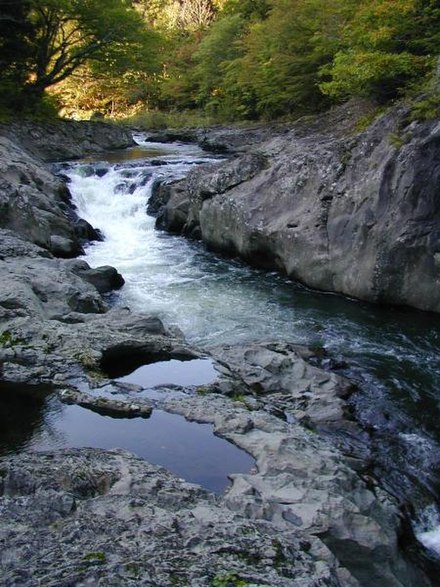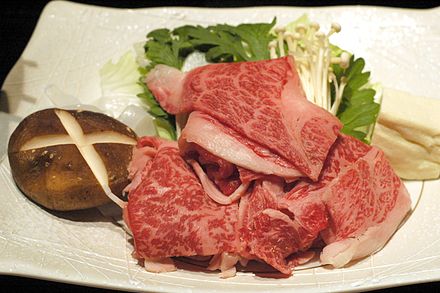Tohoku - region in the northeastern portion of Honshu, Japan
Tohoku (東北 Tōhoku, literally "East-North") is the northeastern region of Japan's Honshu island. In winter, the Snow Country (Yukiguni) of the western Japan Sea coast racks up some of the highest snowfall figures in the world, which also means great skiing and lots of hot springs to warm up in. Tohoku also has many castles and samurai residences, making it a good place to take in some history. It also serves as a good backup plan for cherry blossom viewing, since the trees blossom a few weeks later here than they do in Tokyo/Kyoto.
Understand
Traditionally a poor rural backwater with a harsh climate, today's Tohoku offers the traveller some of the best scenery in Japan.
The Tohoku region, while a popular destination for domestic travel and tourism, is virtually untouched by foreign tourism. Tohoku has primarily marketed itself as a ski destination to domestic travelers, and while the region has well developed transportation and ski infrastructure, its overall tourism infrastructure is relatively lacking for foreign tourism (especially budget tourism). For example, the entire prefecture of Akita only contains 2 hostels, with prices not too far off from business hotels. Despite this, Tohoku's tourism associations aggressively market Tohoku as a destination for international travelers through Youtube and Instagram influencers. Nonetheless, Tohoku can be a rewarding trek off the beaten path, for those who are willing to contend with limited tourism infrastructure.
Prefectures

Known for its scenic coast, beautiful women, milky white hot springs, and namesake dog breed.
The northernmost part of Tohoku, home to the region's only original castle and the so-called Gateway to Hell.
Formerly Aizu Province, its former glory can be felt in Aizu-Wakamatsu.
Famed for the kappa town, Tono, and the culture-rich former capital of northern Japan, Hiraizumi
Home to Sendai, the region's largest city, the squeaky cute Naruko kokeshi dolls, and the famed "Top 3 View" Matsushima
Full of hidden treasures from the pilgrimage temples of the Dewa Sanzan to the small hot spring village of Ginzan Onsen.
Cities
- Aizu-Wakamatsu — Former castle town rich in history
- Akita — capital of Akita Prefecture
- Aomori — northernmost city in Honshu
- Hiraizumi — historical site with several large temples
- Hirosaki — the cultural capital of the North
- Kakunodate - Preserved samurai district famous for its cherry blossoms
- Morioka — capital of Iwate with beautiful rivers
- Sendai — capital of Miyagi and the largest city in Tohoku. It enjoys the epithet Mori no Miyako, "The Forest City", due to its dense tree lined thoroughfares and forested public areas.
- Yamagata — featuring the mountain temple of Yamadera
Other destinations
- Dewa Sanzan a set of three temples representing birth, death, and rebirth, popular among pilgrims
- Kinkazan — small island with a shrine and hiking trails
- Matsushima — one of Japan's Three Great Views
- Mount Bandai
- Naruko — famous for its hot springs and kokeshi dolls
- Shimokita Peninsula — featuring the scenic Yagen Valley as well as Mount Osore, the mythical entrance to Hell
- Shirakami-Sanchi Protected natural forests and mountains straddling the border of Aomori and Akita prefectures, designated as a World Heritage Site.
- Towada-Hachimantai National Park — scenic Lake Towada, gorgeous Oirase River Valley and the hot springs of Hachimantai Plateau
- Nyuto Onsen — popular hitō (hidden hot spring) resort in rural settings in Akita.
Itineraries
- Narrow Road to the Deep North — in the footsteps of haiku poet Matsuo Basho
Travel Topics
- Dewa Sanzan — three mountains holy to the ascetic cult of Shugendo
Talk
Information in English tends to be sparse in rural Tohoku, since foreign travellers are few in these parts; most people are also apprehensive around foreigners even if you can speak Japanese.
The Tohoku dialect (東北弁 Tōhoku-ben) is perceived as quite rural by Japanese, and it gets thicker the further north you go. It's known as zūzū-ben for its characteristic feature of turning all "s" sounds into "z" and blending "i" and "u" vowels. It can be difficult to comprehend at times even if you do understand Japanese, and the use of different vocabulary in some dialects makes them harder even for those from different parts of Tohoku. Most people are however well versed in Standard Japanese (hyōjungo), and English is also somewhat spoken by urban youth.
Get in
By plane
There are no major airports in Tohoku and most travellers arrive via Tokyo. Sendai and Akita airports do field some international flights, mostly to China and South Korea.
By train
The Tohoku Shinkansen connects Tokyo, Sendai, Morioka and Aomori, with spur lines to Akita and Yamagata. It will take 1 hour 40 minutes from Tokyo to Sendai via the all-reserved Komachi and Hayabusa service, which run nonstop after departing Omiya in Saitama prefecture. Trains run through to the Hokkaido Shinkansen to Hakodate.
By ferry
Ferry services connect ports in northern Tohoku to Hokkaido and Nagoya.
Get around
Tohoku is large, mountainous and sparsely populated, and getting around in the boondocks can be time-consuming.
By train
Tohoku's main train artery is the Tōhoku Shinkansen (東北新幹線) bullet train line on the east coast, connecting Tokyo to Aomori via Sendai, Fukushima, Morioka and Hachinohe, with spurs to Yamagata and Akita. An extension across the strait to Hakodate is now open, but the rest of the route to Sapporo won't open until 2030.
Outside the Shinkansen network, rural train services in Tohoku, known affectionately as donko, are slow and infrequent. It's not unusual to have waits of 2 or even 4 hours between trains, especially for services crossing the sparsely inhabited interior, and buses are often a faster option for intercity travel. The scenery along the twisty mountain routes can be stunning though.
While JR has a near-monopoly for connecting all major towns together, the stretch of ordinary track between Morioka and Aomori now belongs to a private company, and there are bits and pieces of private railways around the larger towns.
JR East Rail Pass
The JR East Rail Pass (Tohoku area) lets you travel for free on all JR East lines in the Tohoku and Kanto regions including the Tohoku Shinkansen and its spurs, and is a good option if you plan to travel extensively by train. The cost of the pass is ¥19,000 for any five days of travel within 14 days. The pass does not cover the Nagano and Niigata areas of JR East.
The JR East pass covers the area around and North of Tokyo on Honshu, including Nikko for instance, and can be used on the Shinkansen north-bound from Tokyo. Unlike the Japan Rail Pass, it covers the private Izu-Kyuko Railway from Ito to Shimoda, limited express trains from Tokyo to Nikko and Kinugawa via the JR and Tobu Railway lines, local Tobu Railway trains from Shimo-Imaichi to Nikko and Kinugawa, and the Hokuetsu Railway between Echigo Yuzawa and Naoetsu; however, it cannot be used on the Tokaido Shinkansen to go to Kyoto and Osaka.
If you're not in a hurry, you may also want to consider the cheaper Seishun 18 Ticket.
By bus
Especially for traveling west-east, buses are often a faster and sometimes even cheaper alternative to trains. For example, traveling by train from Morioka to Hirosaki takes around 4 hours even if you time your connection right, while a direct, hourly bus covers the same distance in just over 2. Buses usually leave from major train stations, and the largest operator is JR Bus Tohoku.
By car
Tohoku (in particular north of Sendai) is one of the few areas in Japan where you might want to rent a car. Rental car outlets are conveniently located near the train stations in the major cities, as this is the way local business travellers get around. When planning your trips, figure on your average travel speed on the road being around 60km/h. All sight-seeing spots have parking available, which is inexpensive as compared to the cities in the south. Note that in winter, many roads are closed entirely, and even major arteries can be temporarily blocked by heavy snowfall.
For long distance travel, the Tohoku Expressway more or less follows the route of the Shinkansen, but it's a solid 10 hours of driving for the 900 km from Tokyo to Aomori. A good starting point for exploring Tohoku is Morioka, which can be reached by train from Tokyo in 2½ hours on the Hayate or Komachi service.
See
.jpg/440px-Tsuruga-jo_castle_(37807740366).jpg) Most visitors come to Tohoku for hiking, nature, history and hot springs, not necessarily in that order. Highlights include the temples of Hiraizumi, the holy mountains of Dewa Sanzan and the secluded hot springs of the Shimokita Peninsula. Heavy snowfall also makes this a top skiing destination in winter, but due to longer access times from the main cities, the resorts tend to be less developed (and less crowded) than those around Nagano.
Most visitors come to Tohoku for hiking, nature, history and hot springs, not necessarily in that order. Highlights include the temples of Hiraizumi, the holy mountains of Dewa Sanzan and the secluded hot springs of the Shimokita Peninsula. Heavy snowfall also makes this a top skiing destination in winter, but due to longer access times from the main cities, the resorts tend to be less developed (and less crowded) than those around Nagano.
World Heritage Sites
- Shirakami-Sanchi Home to Asia's largest natural beech forest
- Hiraizumi Pure Land Buddhist sites from the former capital of the Tohoku Region
- Sites of Japan’s Meiji Industrial Revolution: Iron and Steel, Shipbuilding and Coal Mining - The Hashino Iron Mining and Smelting Site is listed among the many sites that make up this World Heritage Listing (Kamaishi)
Castles
Original castles
- Hirosaki Castle The northernmost of Japan's 12 original castles and the only one located in the Tohoku Region, famous for its cherry blossom festival (Hirosaki)
Reconstructed castles
- Aizu-Wakamatsu Castle The largest castle in the region in the former powerful Aizu Province (Aizu-Wakamatsu)
- Yamagata Castle The castle gate has been reconstructed and excavations around the site remain ongoing
- Yokote Castle A small castle known for cherry blossoms in spring and kamakura igloo festival in winter (Yokote)
- Shirakawa Castle (Shirakawa)
- Kubota Castle (Akita)
Castle ruins
Temples and shrines
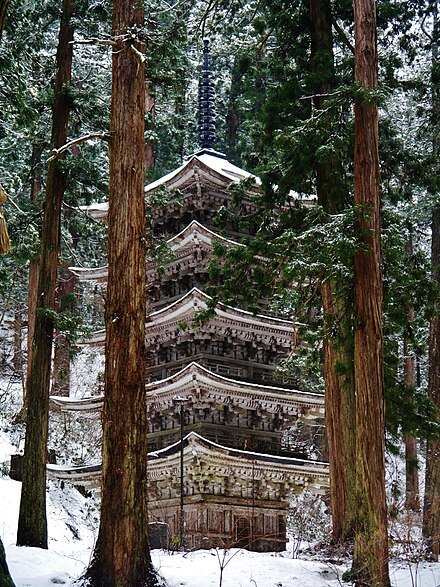
- Dewa Sanzan - A group of 3 temples serving as spiritual centers of shugendo mountain worship, Hagurosan is famous for its pagoda.
- Bodaiji Temple - Known as the "Gateway to Hell" and one of Japan's Top 3 spiritual sites (Osorezan)
- Chusonji Temple The most famous of Hiraizumi's temples, known for its golden hall. (Hiraizumi)
- Yamadera - One of Japan's most picturesque mountain temples (Yamagata)
- Zuihoden Housing the famous lord Date Masamune's grave (Sendai)
- Zuiganji Temple and Godaigo Hall Scenic temples around Matsushima Bay (Matsushima)
Gardens
- Oyakuen Garden (Aizu-Wakamatsu
- Fujita Memorial Garden (Hirosaki)
- Seibien Garden (Hirosaki)
- Suirakuen Garden (Shirakawa)
- Honma Art Museum (Sakata)
- Jorakuen Garden (Fukushima)
- Ikeda-shi Garden (Daisen)
- Gokurakuen Garden (Tendo)
- Flower and Garden Mori no Kaze (Shizukuishi)
Historic Districts
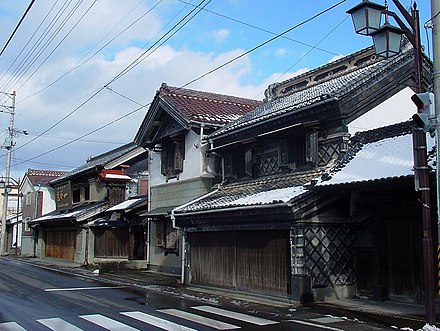
- Ouchijuku (Shimogo)
- Kitakata (Kitakata)
- Nakamachi's Komise-dori (Kuroishi)
- Kakunodate (Senboku)
- Masuda (Yokote)
- Murata (Murata)
- Maezawa (Minami-Aizu)
Museums
- Towada Art Center (Towada) - A world-class modern art museum
- Sannai Maruyama Historical Site (Aomori) - A museum and World Heritage Site over a former Jomon Period settlement.
- Ken Domon Museum of Photography (Sakata)
- Yokote Masuda Manga Museum (Yokote)
- Miyazawa Kenji Dowa Mura (Hanamaki) - An art museum that takes the works of Miyazawa Kenji and makes them interactive
- Tohoku History Museum (Tagajo) - Exhibits and displays about the history of the entire Tohoku Region
- Tsugaru Kokeshi-kan (Kuroishi) and Miyagi Zao Kokeshi-kan (Zao) are dedicated to their respective local kokeshi
- Rias Ark Museum of Art (Kesennuma)
- Iwate Tsunami Memorial Museum (Rikuzentakata) - A museum dedicated to the March 11 Earthquake, including the "Miracle Pine".
Do
Onsen
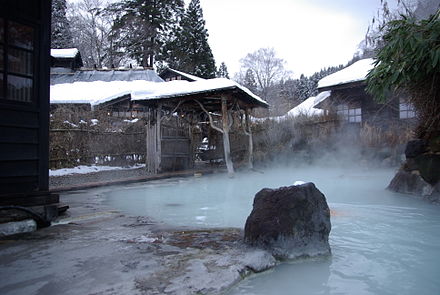
The Tohoku region is home to some of Japan's most beautiful and secluded hot springs. Ginzan Onsen in Obanazawa and Nyuto Onsen in Senboku are often considered among the most beautiful onsen in the country. Nyuto Onsen features rustic buildings, milky white waters, and surrounding nature, while Ginzan Onsen is a nostalgic town of Taisho-era inns separated by the Ginzan River running through the center. The golden Koganezaki Furofushi Onsen that rests along the Sea of Japan in Fukaura is famous for its seaside views and sunsets.
Kokeshi are popular souvenirs in Tohoku that are actually associated with onsen. There are 11 kokeshi varieties, each associated with specific onsen towns in the Tohoku region (except for the Yamagata Kokeshi, which doesn't have an associated onsen but can be found in Yamagata and Yonezawa). Tsugaru Kokeshi are from Kuroishi Onsen in Kuroishi, Kijiyama Kokeshi from Doroyu Onsen and Oyasu Onsen in Yuzawa, Nanbu Kokeshi from Hanamaki Onsen in Hanamaki, Hijiori Kokeshi from Hijiori Onsen in Okura, Zao Takayu Kokeshi from Zao Onsen in Yamagata, Togatta Kokeshi from Togatta Onsen in Zao, Naruko Kokeshi from Naruko Onsen in Osaki, Sakunami Kokeshi from Sakunami Onsen in Sendai, Yajiro Kokeshi from Kamasaki Onsen in Shiroishi, and Tsuchiyu Kokeshi from Tsuchiyu Onsen in Fukushima.
Festivals
 Tohoku has lots of famous festivals. The Nebuta Festival in Aomori, Kando Festival in Akita, and Tanabata Festival in Sendai are together known as the Tohoku's Top Three Festivals. After the Tohoku Earthquake in 2011, the 6 prefectures of Tohoku decided to create a new festival that featured the largest summer events of each prefecture, known as the Tohoku Rokkonsai. The top three festivals were the representative festivals of Aomori, Akita, and Miyagi, and the Hanagasa Festival in Yamagata, Sansa Festival in Morioka, and Fukushima's Fukushima Waraji Festival were chosen to represent Yamagata, Iwate, and Fukushima respectively. The Tohoku Rokkonsai is a parade featuring troupes of each prefecture, allowing spectators to enjoy a bit of each without having to travel to all of the prefectures. It is held in a different prefecture every year.
Tohoku has lots of famous festivals. The Nebuta Festival in Aomori, Kando Festival in Akita, and Tanabata Festival in Sendai are together known as the Tohoku's Top Three Festivals. After the Tohoku Earthquake in 2011, the 6 prefectures of Tohoku decided to create a new festival that featured the largest summer events of each prefecture, known as the Tohoku Rokkonsai. The top three festivals were the representative festivals of Aomori, Akita, and Miyagi, and the Hanagasa Festival in Yamagata, Sansa Festival in Morioka, and Fukushima's Fukushima Waraji Festival were chosen to represent Yamagata, Iwate, and Fukushima respectively. The Tohoku Rokkonsai is a parade featuring troupes of each prefecture, allowing spectators to enjoy a bit of each without having to travel to all of the prefectures. It is held in a different prefecture every year.
The Omagari Fireworks in Daisen is one of the most famous fireworks festivals. In the winter, the Yokote Kamakura Festival in Yokote features Japanese igloos around Yokote Castle and the Hirosaki Castle Winter Festival in Hirosaki feature colorful snow lanterns lit around the castle at night. During New Years the Namahage come out in Oga to find naughty children and imbibe in sake.
Eat
Originally peasant food for long winters, Tohoku food tends to be strong flavoured and salty, and the area is famous for its pickles. In mountain regions you will certainly have a chance to sample sansai-ryōri (山菜料理), prepared from herbs and plants harvested from the forests and hillsides. Rice from Tohoku is also famous, with Miyagi's sasanishiki (ササニシキ) and Akita's Akita-komachi (秋田小町) being the flagship varieties.
Tohoku is an important fruit production area and produces most of Japan's apples (Aomori), pears (Yamagata), cherries (Yamagata) and peaches (Fukushima). Yonezawa in Yamagata is famed for beef, and beef tongue is a specialty of Sendai. Akita is best known for kiritanpo (きりたんぽ), a hot pot with pounded rice and a chicken stock. Horsemeat is commonly eaten in mountain regions of Iwate.
Drink
Unlike the shōchū-swilling south, Tohoku is sake country and manufactures some fine rice wines.
Go next
- Japan's northernmost main island of Hokkaido is a short hop away from Tohoku's northern tip.
